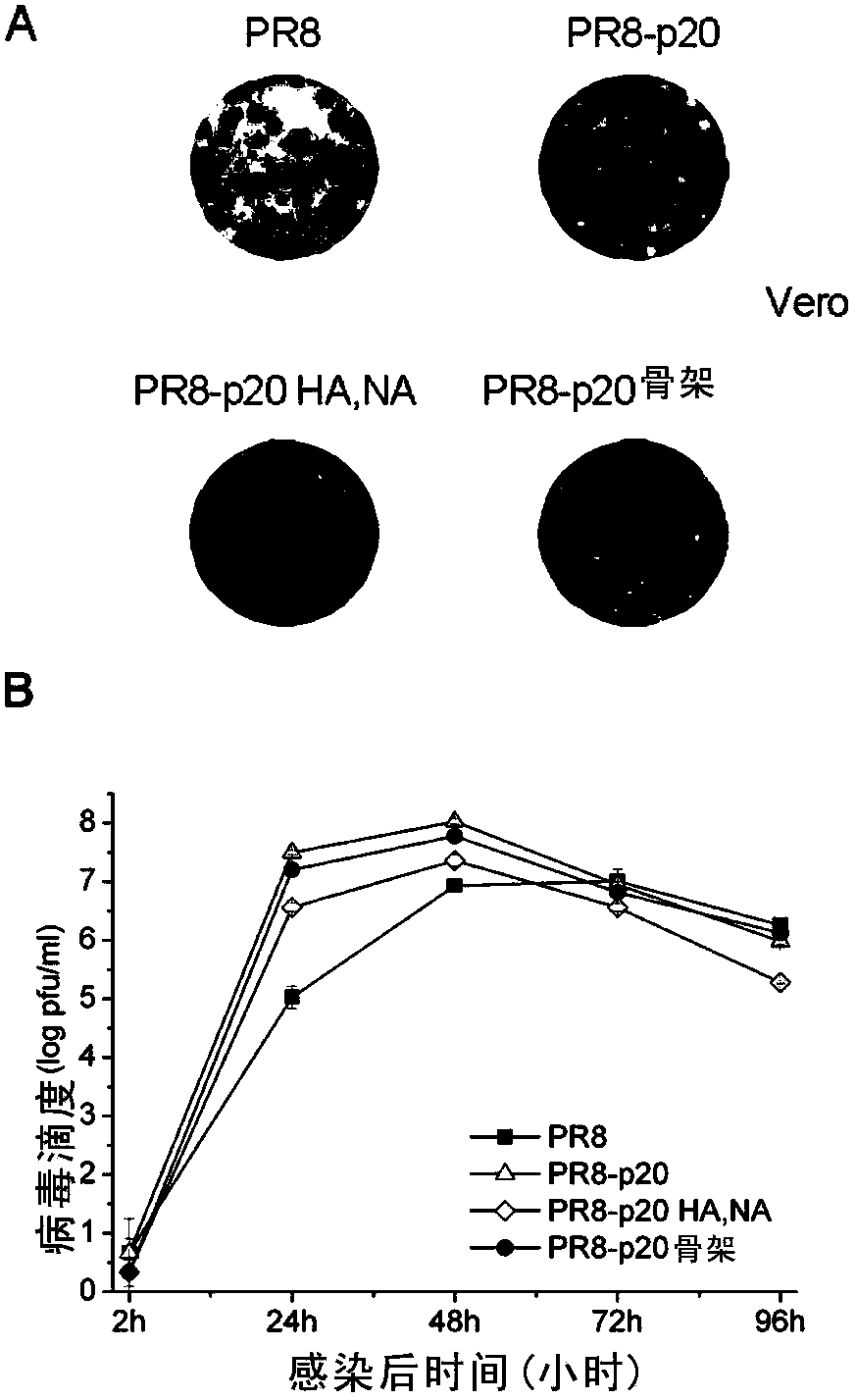Obtaining method and adaptation site of mammalian cell-adapted strain of influenza A virus vaccine
A type of influenza A virus, influenza virus technology, applied in the fields of biotechnology and immunology
- Summary
- Abstract
- Description
- Claims
- Application Information
AI Technical Summary
Problems solved by technology
Method used
Image
Examples
Embodiment 1
[0183] Example 1, PR8 was continuously passaged in Vero cells to obtain a greatly accelerated adaptive strain PR8-p20
[0184] The growth rate of PR8 in Vero cells was slow, and only small plaques could be formed 48h after infection ( figure 1 A). In the presence of 1 μg / μl TPCK-trypsin, inoculated at MOI=0.001, after 24 hours, the virus titer was only 10 4.5 PFU / ml, it takes at least 48h for the virus titer to reach a peak value of about 10 6.5 PFU / ml( figure 1 B). Such a growth rate is difficult to meet the needs of vaccine production.
[0185] Therefore, the inventors obtained a Vero-adapted strain of PR8 virus with increased growth rate by continuous passage on Vero cells. After Vero cells were uploaded for 10 passages, the plaques formed by PR8 became significantly larger. After 20 passages, PR8 can form larger plaques. Viral RNA was extracted from the strain after 20 passages, and the viral cDNA was obtained by reverse transcription, which was cloned into the reve...
Embodiment 2
[0194] Embodiment 2, internal virus gene is sufficient to support the rapid growth characteristic of PR8-p20
[0195] In order to find out the mutation site that makes PR8-p20 gain adaptability, the inventors sequenced the whole genome of PR8 and PR8-p20, and found a total of 13 amino acid site mutations, distributed in HA, NA, NS1, NP, PA , PB1 and PB2 seven proteins (Table 1). Considering the need to obtain a high-yielding PR8 backbone, the present inventors therefore investigated whether external or internal viral genes contributed to the rapid growth properties of PR8-p20.
[0196] The present inventor constructed two strains of recombinant viruses, one contained the external gene HANA of PR8-p20, and the internal six genes (NP, M, NS, PA, PB1, PB2) came from PR8, named PR8-p20HA / NA .
[0197] The HA and NA of another strain virus come from PR8, and the internal 6 genes (NP, M, NS, PA, PB1, PB2) come from PR8-p20, named as PR8-p20 backbone.
[0198] Plaque experiments s...
Embodiment 3
[0200] Example 3. Four point mutations on the polymerase and NS1 proteins determine the rapid growth characteristics of the PR8-p20 backbone
[0201] In order to further determine the point mutations that contribute to the rapid growth characteristics of the PR8-p20 backbone, the inventors constructed single-gene recombinant viruses for the five genes carrying the mutations, named PR8-p20NS, PR8-p20NP, PR8-p20PA, PR8 - p20PB1 and PR8-p20PB2; and single point mutant viruses PR8-NP S377N and PR8-NP N309H.
[0202] Through plaques on Vero cells ( image 3 A) and growth curve experiment ( image 3 B) Evaluation of the growth characteristics of these viruses. The results showed that PR8-p20NP and PR8-p20PB1 could form significantly larger and clearer plaques than PR8, and the growth rate was also significantly accelerated. The growth rate of PR8-p20NS and PR8-p20PA was slightly faster than that of PR8. However, the growth rate of PR8-p20PB2 was not increased compared with PR8. ...
PUM
 Login to View More
Login to View More Abstract
Description
Claims
Application Information
 Login to View More
Login to View More - R&D
- Intellectual Property
- Life Sciences
- Materials
- Tech Scout
- Unparalleled Data Quality
- Higher Quality Content
- 60% Fewer Hallucinations
Browse by: Latest US Patents, China's latest patents, Technical Efficacy Thesaurus, Application Domain, Technology Topic, Popular Technical Reports.
© 2025 PatSnap. All rights reserved.Legal|Privacy policy|Modern Slavery Act Transparency Statement|Sitemap|About US| Contact US: help@patsnap.com



